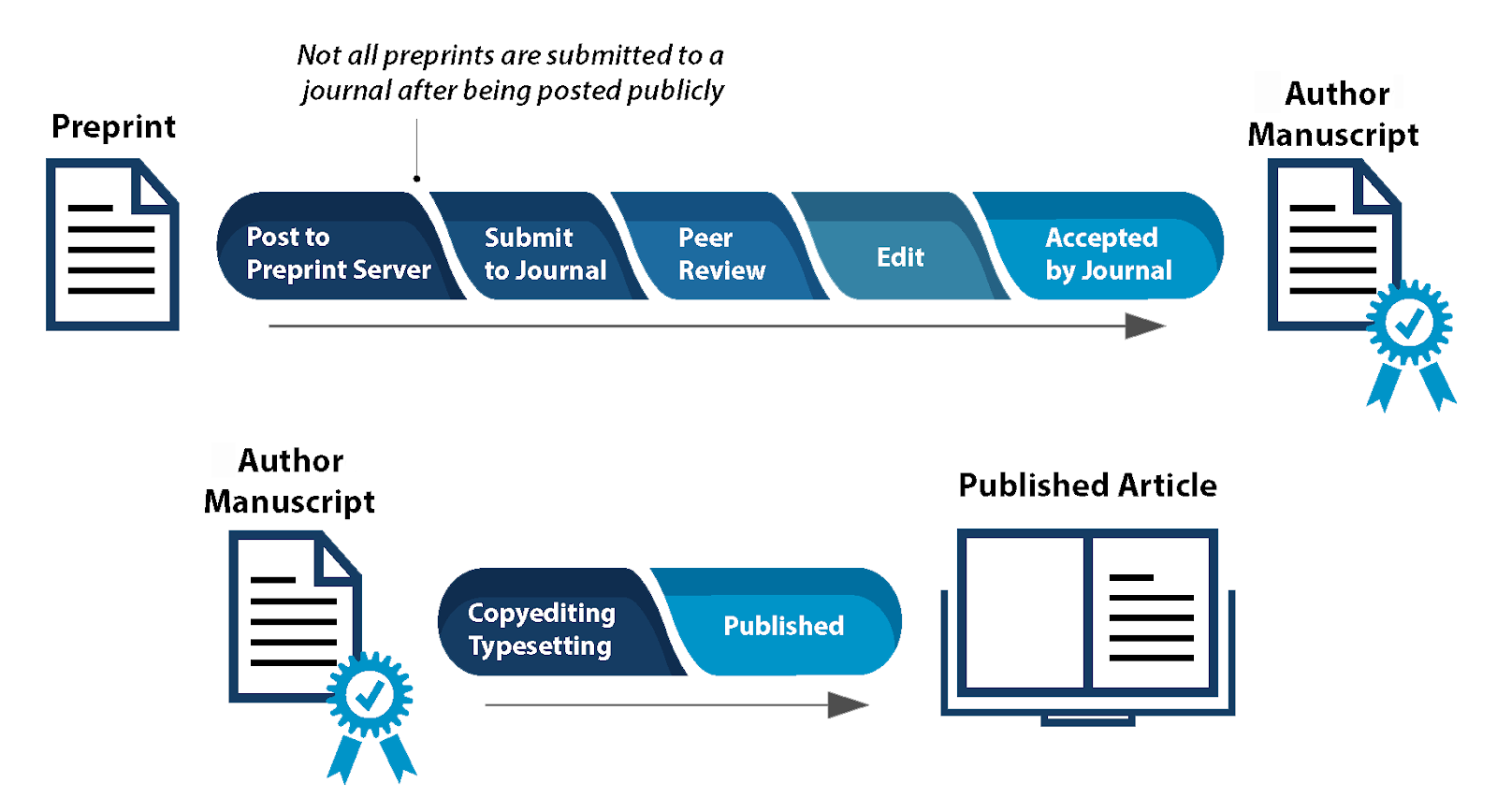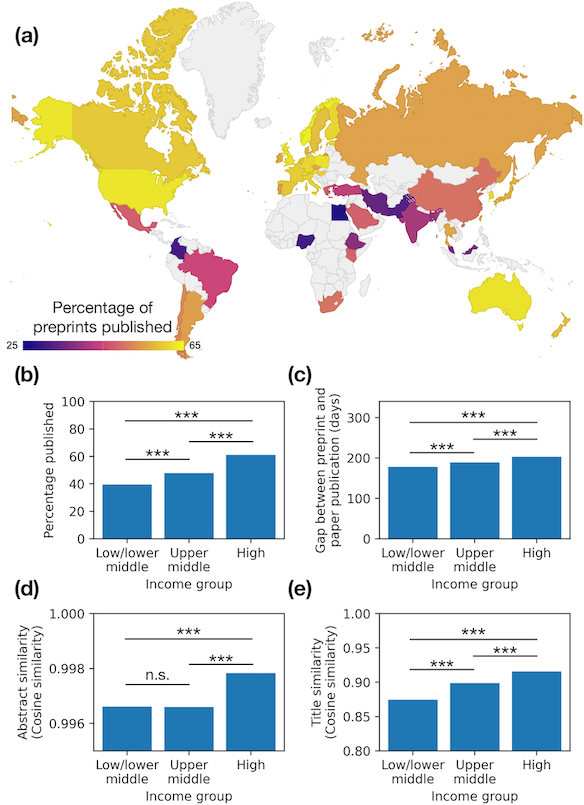Preprint servers first emerged in the early 1990s, providing researchers with a platform to share early versions of their research paper with the scientific community prior to formal peer review and publication. These digital repositories have since become pivotal platforms shaping the dissemination and collaboration process and are revolutionizing the speed and accessibility of scholarly communication. In fact, some researchers class them as indispensable allies in the research process. From accelerating the pace of scientific discovery to fostering transparency and collaboration, these platforms have redefined how scholars engage with and contribute to their fields.
Join us as we explore the function of preprint servers in the modern research journey, exploring their significance, advantages, and impact on the scientific ecosystem, alongside the potential drawbacks that preprint servers can have on research integrity and the reliability of scientific knowledge.
What is the difference between a manuscript and a preprint?
In the realm of academic publishing, the terms "manuscript" and "preprint" are often used interchangeably, yet they represent distinct stages in the research dissemination process. Understanding the difference between these two concepts is crucial for researchers navigating the scholarly communication landscape.
A manuscript typically refers to the finalized version of a research paper that has undergone peer review and editorial revisions, ready for publication in a scholarly journal. This stage represents the culmination of the research process, where findings are presented in a polished format, adhering to the journal's formatting and citation style requirements. Manuscripts undergo rigorous scrutiny by peer reviewers who assess the validity, significance, and methodology of the research before it is accepted for publication. Upon acceptance, manuscripts are often subject to further revisions and editing by journal editors to ensure clarity, coherence, and adherence to publication standards.
In contrast, a preprint is an earlier version of a research paper that is shared publicly on a preprint server before undergoing formal peer review and publication in a scholarly journal. Preprints provide researchers with a means to disseminate their findings rapidly and solicit feedback from the academic community before finalizing their manuscripts.
Unlike manuscripts, preprints are typically in a raw or draft form, may contain preliminary data or analyses, and have not been subjected to the rigorous scrutiny of peer review. However, preprints still adhere to basic standards of scientific integrity and are often accompanied by disclaimers highlighting their provisional nature and the need for peer review.

The primary distinction between manuscripts and preprints lies in their stage of development and the level of peer review scrutiny they have undergone. Manuscripts represent the culmination of the research process, having been vetted by peer reviewers and editors for publication in scholarly journals. Preprints, however, offer researchers a means to share their findings quickly and receive early feedback from peers, facilitating collaboration and accelerating the dissemination of knowledge.
In studies conducted in Germany and the United States, Wingen, Berkessel, and Dohle (2022) examined how preprints impact nonscientists' credibility perception over concerns that nonscientists may not differentiate preprints from peer-reviewed literature, potentially leading to overconfidence in unvalidated findings. The findings from a number of the studies revealed that without an explanation into the peer-review process, nonscientists perceive preprints as equally credible as peer-reviewed articles.
In sum, manuscripts and preprints serve distinct purposes in the research dissemination process, with manuscripts representing finalized papers accepted for publication in scholarly journals, and preprints serving as early versions shared publicly before peer review. Understanding these differences is essential for researchers navigating the scholarly publishing landscape and leveraging the benefits of both manuscript submission and preprint sharing in advancing scientific knowledge.
Has a preprint ever been mistaken for a manuscript?
One notable example of preprints being mistaken as manuscripts was during the COVID-19 pandemic when several preprints were misunderstood or misrepresented by media outlets or individuals without the necessary expertise to interpret the findings accurately. This led to misinformation spreading rapidly, potentially influencing public perception, policy decisions, and even clinical practices.
For instance, in late January 2020, a preprint published on bioRxiv by researchers from the India Institute of Technology claimed they found HIV-like insertions in the spike protein of SARS-CoV-2, suggesting potential intentional manipulation of the virus. This was quickly deemed to be untrue.
The rapid dissemination of preprints during a public health crisis highlighted the importance of clear communication regarding the provisional nature of preprints and the need for cautious interpretation by both the scientific community and the general public. While preprints play a valuable role in accelerating the sharing of research findings, this instance underscores the importance of exercising caution, responsible reporting, and critical appraisal when engaging with preprint literature to maintain research integrity and prevent the dissemination of misleading or premature information.
On a more encouraging note, Oransky and Marcus, writing for STAT, observed that bioRxiv’s withdrawal of the preprint occurred swiftly due to the agility of preprint servers, which in turn, prevented widespread coverage by news outlets. In contrast, peer-reviewed journals flagged for misconduct often take years to retract fully. They add that “Just like in politics, maybe it’s time to agree that the publishing process is a messy one, and stop using single episodes [like the preprint published on bioRxiv], free of context, to score points against one’s rivals."
How do preprint servers benefit scientific authors?
Open access to research
Preprint servers promote open access to scientific research by making preprints freely available to anyone with an internet connection. This accessibility democratizes knowledge and allows researchers from around the world to access and build upon each other's work, irrespective of institutional affiliations or subscription barriers. Eckmann and Bandrowski (2023) note that preprints are “more equitably distributed across countries and income groups than their later outcome of publication” which “argues against the criticism that preprints push out niche groups from mainstream scholarly research”.

Rapid dissemination of research findings
Preprint servers offer a platform for researchers to swiftly share their latest findings with the scientific community without the delays associated with traditional peer review. This enables researchers to disseminate their work quickly, fostering collaboration and accelerating the pace of scientific discovery. Oransky and Marcus argue that while peer review is valuable, ”those who work in publishing seem to be so wedded to the existing process that they can’t admit its flaws — or that it might be a good idea to also embrace preprint servers that could upend their business models.”
Facilitation of feedback and collaboration
By sharing their research as preprints, researchers invite feedback and constructive criticism from their peers, facilitating collaboration and improvement of their work. Preprints serve as a platform for early-stage discussions and idea-sharing, helping researchers refine their hypotheses, experimental designs, and interpretations before formal peer review.
Increased visibility and recognition
Publishing research as preprints can enhance researchers' visibility and recognition within their respective fields. Preprints often receive widespread attention and citations, even before formal publication in peer-reviewed journals, helping researchers establish their expertise and track record of contributions to their field.
Preprints also serve as a means for early career advancement, providing an opportunity for early career researchers, including graduate students and postdoctoral fellows, to showcase their work and establish themselves as independent researchers. By sharing their findings as preprints, early career researchers can garner feedback, build collaborations, and increase their visibility within the scientific community, ultimately enhancing their prospects for career advancement.
Speaking to Nature, epidemiologist, John Ioannidis, believes that, "[b]y making results more open earlier, they allow more eyes to scrutinize the results and find out errors or ways to improve the work before it gets disseminated as a published paper with a seal of formal publication.”
Flexibility and experimentation
Preprint servers provide researchers with a flexible and experimental platform to explore new ideas and methodologies. Researchers can use preprints to share preliminary findings, negative results, or exploratory studies that may not fit within the constraints of traditional peer-reviewed journals but still contribute valuable insights to their field.
What are the challenges associated with publishing to preprint servers?
Rapid dissemination vs. lack of peer review
One of the key advantages of preprint servers is the rapid dissemination of research findings. However, this comes with the trade-off of bypassing the traditional peer review process, which serves as a key pillar of research integrity and a crucial quality control mechanism in ensuring the validity and reliability of scientific research. Without peer review, there is a risk of misinformation or flawed research being circulated, potentially leading to confusion within the scientific community and among the public.
Bagdasarian, Cross, and Fisher (2020) note that a possible resolve could involve preprint servers “limiting access to subscribers with an academic affiliation, allowing for feedback and input from peers, but at the same time keeping the circle of access limited, until the peer-review process is completed.”
Preprint priority and recognition
Publishing research on preprint servers may provide early visibility and recognition within the academic community. However, some researchers and institutions still prioritize publication in peer-reviewed journals for formal recognition and career advancement. This could create a disparity in how research contributions are perceived and valued, particularly in promotion and funding decisions, where peer-reviewed publications often carry more weight. Therefore, it's important to consider the implications of publication venue choice on career advancement and to ensure that researchers are evaluated based on the quality and impact of their work rather than solely on the publication venue.
In an editorial published by Avissar-Whiting et al. (2024) advocate for rethinking the traditional peer-review process in light of the increasing use of preprints, suggesting that preprints enable more thorough, inclusive, and collegial peer review, and calls for stakeholders to accelerate preprint sharing and empower researchers to provide open and constructive peer review.
Potential for misuse and misinterpretation
Preprints are preliminary versions of research papers and may contain incomplete data, errors, or interpretations that could change after peer review. Despite disclaimers highlighting the provisional nature of preprints, there is a risk that media outlets or individuals might misinterpret or sensationalize findings, leading to misinformation spreading rapidly before corrections or clarifications are made.
Impact on traditional publishing models
The rise of preprint servers has challenged the traditional publishing model dominated by subscription-based journals. While preprints promote open access to research and facilitate collaboration, they also raise questions about the sustainability of traditional publishing models and the financial viability of journals. For instance, arXiv, a preprint server primarily used in physics, mathematics, computer science, and other fields, has provided researchers with a platform to share their findings openly and freely with the scientific community for over 30 years.
Similarly, bioRxiv, a preprint server focused on biology, has gained popularity among researchers seeking to disseminate their work rapidly and solicit feedback before formal peer review.This could have implications for the funding mechanisms of academic publishing and the long-term viability of scholarly communication platforms.
Risk of misappropriation
By making research findings publicly accessible before undergoing formal peer review, preprints may become targets for unethical individuals seeking to exploit others' intellectual contributions without proper attribution. Teixeira da Silva (2018) asks the question, “could preprints be used for intellectual phishing, that is, an attempt to gather intellectual ideas from the public to improve a paper?” If the answer to this question is affirmative, it raises concerns about the integrity of the preprint model and its susceptibility to abuse, potentially undermining trust in the entire preprint publishing process.
Potential for plagiarism
While preprint servers themselves do not inherently encourage plagiarism, their existence and the rapid dissemination of research findings they facilitate could potentially create conditions conducive to plagiarism if not managed appropriately.
In competitive research environments where publication metrics carry significant weight, there may be pressure on researchers to publish their findings quickly. Preprint servers offer a means to communicate findings fast, but typically have minimal or no oversight over the content uploaded to their platforms. Being under undue pressure to publish, this could lead some individuals to cut corners and resort to plagiarism as a shortcut to producing publications at speed.
While some preprint servers implement basic screening processes to filter out inappropriate content, they generally do not conduct thorough checks for plagiarism. This lack of oversight may embolden individuals inclined towards plagiarism to upload unoriginal work to preprint servers without fear of detection.
How is AI writing impacting preprint servers?
One of the most significant risks of AI writing in the context of preprints lies in the potential for generating inaccurate or misleading content. AI systems may struggle to comprehend the nuances of scientific language and concepts, leading to the creation of summaries or interpretations that misrepresent the original research.
In a recent article by Nature, it was revealed that bioRxiv has integrated large language models (LLMs) to automatically generate summaries for newly posted manuscript preprints, with the aim of improving accessibility and understanding of scientific research. While this innovative approach holds promise for aiding readers in navigating the extensive volume of preprints, initial assessments highlight notable challenges in accurately summarizing complex technical content using artificial intelligence (AI). Notably, computational biologist, Erik van Nimwegen, criticized the coherence of a summary generated by an AI writing tool for his preprint, expressing frustration by stating, “I’d rather have no summaries than this hash.”
Despite these early setbacks, the ongoing evolution of AI capabilities and the development of specialized scientific language models offer potential for automated summarization tools to become valuable resources for researchers, provided concerns regarding accuracy and reliability are effectively addressed. Achieving a balance between AI-generated summaries and human oversight will be pivotal in harnessing the full potential of AI tools to enhance access to scientific knowledge while upholding standards of accuracy and integrity within the expanding realm of research literature.
Overview: The function of preprint servers in the modern research journey
Preprint servers have emerged as indispensable platforms, reshaping the dissemination process and accelerating the pace of discovery. From fostering collaboration to democratizing access to knowledge, preprints offer unprecedented opportunities for researchers worldwide.
However, amidst the benefits lie challenges: the balance between rapid dissemination and peer review, potential for misinterpretation, and the evolving impact of AI on content generation. As we navigate these complexities, it's imperative to uphold the integrity of research, prioritize transparent communication, and empower researchers with the tools needed to navigate this evolving landscape responsibly.
Fry, Marshall, and Mellins-Cohen (2019), aptly assert that “[w]hilst the ‘reader beware’ tag remains sound sense for preprints – as indeed for all sources to be evaluated by scientists and journalists – we also believe that science benefits from openness.”
By embracing preprints while remaining vigilant against potential pitfalls, we can harness their full potential to advance scientific knowledge collaboratively and responsibly.




